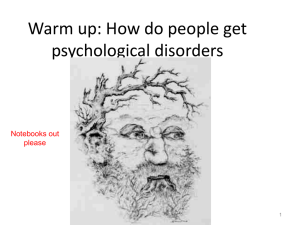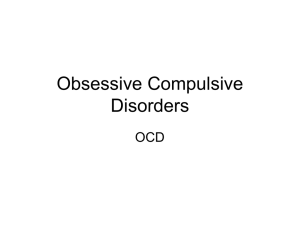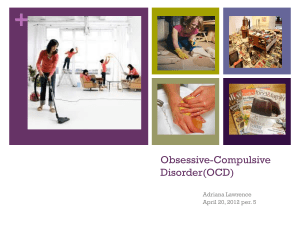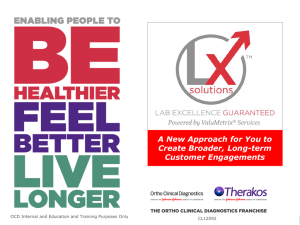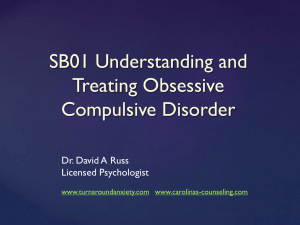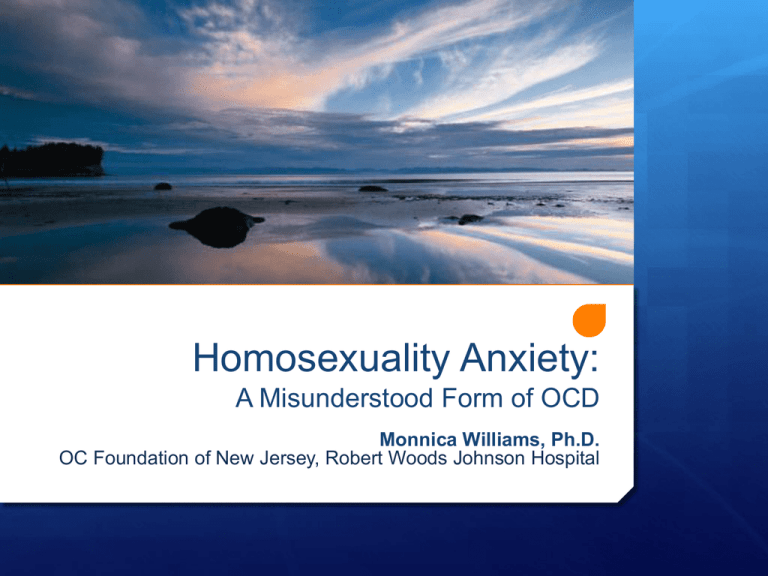
Homosexuality Anxiety:
A Misunderstood Form of OCD
Monnica Williams, Ph.D.
OC Foundation of New Jersey, Robert Woods Johnson Hospital
Introductions
Assistant Professor of Psychology in Psychiatry
Center for the Treatment and Study of Anxiety
University of Pennsylvania, School of Medicine
Department of Psychiatry
Phone: 267-626-6018
Specializes in research and treatments for OCD & PTSD
2
Obsessive-Compulsive Disorder
Obsessions
Unwanted, recurrent, disturbing thoughts that the person
cannot suppress and which can cause overwhelming
anxiety
Compulsions
Repetitive, ritualized behaviors that the person feels driven
to perform to alleviate the anxiety of the obsessions
Prevalence of OCD
Lifetime prevalence at 1.6% in the general population
(Kessler, Berglund, & Demler, 2005)
3
OCD is Serious: Human Toll
Severe Distress
Anxiety
Depression
Suicidal ideation
Disability
Social Impairment
Family Problems
4
OCD Sub-Types
Sub-types of OCD
(Abramowitz, Franklin, Schwartz, & Furr, 2003)
Aggression & Harming (by accident or on purpose)
Contamination & Washing
Hoarding
Symmetry & Ordering
Unacceptable thoughts & Mental Rituals
Common unacceptable thoughts
Religious or blasphemous
Violent
Sexual thoughts
5
Sexual Obsessions
25% experienced sexual obsessions currently or in the
past (Grant et al, 2006)
Actual prevalence rates may be higher
Common themes include unfaithfulness, incest,
pedophilia, unusual behaviors, AIDS, profane thoughts
combining religion and sex, and homosexuality
(Gordon, 2002)
6
Obsession vs. Fantasy
Sexual obsessions ≠ Sexual fantasies
Normal sexual fantasies are enjoyable and generally harmless
They may consist of wishes or memories of past sexual
experiences
Sexual ideation in OCD is unpleasant and distressing
The individual with OCD does not want the thought to become
real
Sexual obsessions in OCD rarely produce sexual
arousal
Obsessions usually decrease sex drive
The obsessions result in guilt, shame, distress, anxiety
7
About Homosexuality Anxiety
Homosexuality fears have been documented in people
with schizophrenia, panic disorder, and other disorders
Few studies have focused specifically on homosexual
anxiety in OCD
DSM 4 Field Trial identifies 12% with current or past
concerns based on YBOCS (Williams & Farris, 2011)
8% with present concerns
4% with past concerns
8
What Is “H” OCD?
Obsessions
The obsessive fear of being or becoming homosexual
The experience of intrusive, unwanted mental images of
homosexual behavior
The obsessive fear that others may believe one is homosexual
Compulsions
Usually a form of checking
More about this…
Term “HOCD” (Homosexual Obsessive Compulsive Disorder)
evolved out of the online community
9
Examples of Homosexuality Anxiety
Lesbian obsession
heterosexual female health worker finds obsessions are
triggered by contact with attractive women patients
Compulsive checking
20 year old male masturbates to images of men to measure
his sexual valence
Worry about appearing gay
a high-school student who worries that others of the same
sex might find her attractive
10
Differential Diagnosis
Mental health professionals may misdiagnose HOCD
HOCD ≠ Internalized Homophobia (“ego-dystonic
homophobia”)
Few instruments address homosexuality anxiety (1 item
on the YBOCS checklist)
Most with HOCD have OCD symptoms in other areas
Diagnosis may be hard if symptoms limited to
homosexuality obsessions
Gay people with HOCD may have heterosexual worries
too (Goldberg, 1984)
11
HOCD vs Real Sexuality Crisis (1)
OCD
Sexual Identity Crisis
1.
feels more sexually
aroused by people of the
opposite sex
1.
feels more sexually
aroused by people of the
same sex
2.
thoughts about engaging
in same-sex relationships
are unappealing
2.
thoughts about engaging
in same-sex relationships
are arousing
3.
feels anxious about
romantic relationships with
people of the same sex
3.
feels excited about
romantic relationships with
people of the same sex
12
HOCD vs Real Sexuality Crisis (2)
OCD
Sexual Identity Crisis
4.
have most enjoyed sexual
experiences with a person of
the opposite sex
4.
have most enjoyed sexual
experiences with a person of
the same sex
5.
worry about same-sex
thoughts mainly because don't
want to give up opposite sex
5.
worry about same-sex
thoughts mainly because of
what others might think or
religious concerns
6.
not able to stop thinking about
same-sex relationships, and
the thoughts are a severe
distraction
6.
often thinks about same-sex
relationships but able to stop
13
HOCD vs Real Sexuality Crisis (3)
OCD
7.
feel emotional intimacy
with a partner of the
opposite sex
8.
worry that people of the
same sex might be
attracted
9.
fantasize about physical
relationships with opposite
sex (including dreams)
Sexual Identity Crisis
14
7.
feel emotional intimacy
with a partner of the same
sex
8.
like when people of the
same sex are attracted
9.
fantasize about physical
relationships with same
sex (including dreams)
HOCD vs Real Sexuality Crisis (4)
OCD
Sexual Identity Crisis
10. tries to learn more about
10. tries to learn more about
sexual identity issues to
reassure self that not gay
sexual identity issues to
better understand self and
others like self
15
Treating HOCD
Misdirected Intervention
Therapist told male patient to try being with a man, and that
everybody is bisexual
Symptoms became worse and patient became suicidal for 5
months
Cognitive Understanding of HOCD
Patient receiving CBT came to realize he was dealing with
OCD-induced thoughts and an underlying distorted belief
system contributing to depression
People with sexual obsessions may need a longer and
more aggressive course of treatment (Grant et al, 2006)
16
Dos and Don’ts for Therapists
DO: Educate the patient about OCD and how
obsessions are maintained
DON’T: Focus on the possible meaning of the
obsessions
DO: Psychoeducation about sexual thoughts and
sexual orientation
DON’T: Suggest the patient is really gay
DO: Exposures!
17
EX/RP for HOCD
Exposure ideas
Devise a detailed story about the patient actually becoming
gay
Visit gay clubs and bars
Wear some clothing items of the opposite sex
Display a Gay Pride button
Confront obsessions with thoughts like “I guess I might be
gay”
No rituals before or after exposures!
Understanding the specifics of the patient’s fears
essential to devising best exposures
18
Medications
SSRI medications will help alleviate obsessions,
compulsions, and anxiety
One case report of a remission with Prozac of HOCD
Will also cause sexual dysfunction in at least a third of
patients, which may panic HOCD patients
Most OCD patients experience only a 30% reduction in
symptoms
Partial responders may benefit from augmentation with
EX/RP or risperidone (Risperdal)
Current augmentation study underway at Penn and NYC
19
Results of Augmentation Research
Patients on an
SSRI continue to
improve when
CBT (EX/RP) is
added
20
Summary
Sexual obsessions are a common symptom of OCD
Homosexuality anxiety is not to be confused with a
sexual orientation crisis
Cognitive-Behavioral Therapy (EX/RP) and medication
are considered the treatment of choice
Research needed to define scope of problem and how to
best tailor treatment to this population
Research is underway to address these questions
21
Resources
M. Williams: Homosexuality Anxiety: A Misunderstood
Form of OCD. Leading-Edge Health Education Issues. L.
V. Sebeki (eds.). Nova Publishers, 2008
BrainPhysics OCD Mental Health Resource
www.brainphysics.com
NeuroticPlanet OCD Discussion Forum
www.neuroticplanet.com
Scholarly articles about HOCD:
www.MonnicaWilliams.com/publications.php
References
Bystritsky A. (2004). Current Pharmacological Treatments for Obsessive-Compulsive Disorder. Essential
Psychopharmacology, 5:4.
Elmore JL. (2002). Fluoxetine-Associated Remission of Ego-Dystonic Male Homosexuality. Sexuality and Disability,
20(2):149-151.
Foa EB, Kozak MJ, Goodman WK, Hollander E, Jenike MA, & Rasmussen SA. (1995). DSM-IV field trial: Obsessivecompulsive disorder. American Journal of Psychiatry, 152(1): 90-96.
Goldberg RL. (1984). Heterosexual panic. American Journal of Psychoanalysis, 44(2): 209.
Goodman WK, Price LH, Rasmussen SA, Mazure C, Fleischmann RL, Hill CL, Heninger GR, & Charney DS. (1989). The
Yale-Brown Obsessive Compulsive Scale, I: development, use, and reliability. Arch Gen Psychiatry, 46:1006–1011.
Goodwin R, Koenen KC, Hellman F, Guardino M, & Struening E. (2002). Helpseeking and access to mental health
treatment for obsessive-compulsive disorder. Acta Psychiatr Scand, 106: 143–149.
Gordon WM. (2002) Sexual obsessions and OCD. Sexual and Relationship Therapy, 17 (4).
Grant JE, Pintob A, Gunnipb M, Mancebob MC, Eisenb JL, & Rasmussen SA. (2006). Sexual obsessions and clinical
correlates in adults with obsessive-compulsive disorder. Comprehensive Psychiatry, 47: 325-329.
Keller D & Foa EB. (1978). Phenothiazines combined with systematic desensitization in a psychotic patient with
obsessions about homosexuality. Journal of Behavior Therapy and Experimental Psychiatry, 9(3), 265-268.
Kempf EJ. (1920). The psychopathology of the acute homosexual panic. Acute pernicious dissociation neuroses. In:
Psychopathology. Kempf EJ.; Mosby Co., St Louis, MO. pp. 477-515.
Kessler RC, Berglund P, & Demler O. (2005). Lifetime Prevalence and Age-of-Onset Distributions of DSM-IV Disorders
in the National Comorbidity Survey Replication. Archives of General Psychiatry, 62(6): 593-602.
Meyer IH. (2003). Prejudice, social stress, and mental health in lesbian, gay, and bisexual populations: Conceptual
issues and research evidence. Psychological Bulletin, 129(5): 674-697.
Rudden M, Busch FN, & Milrod B. (2003). Panic disorder and depression: A psychodynamic exploration of comorbidity.
International Journal of Psychoanalysis, 84(4): 997-1015.
23
More Information
This slideshow is available as a powerpoint at
www.monnicawilliams.com/publications.php
24

